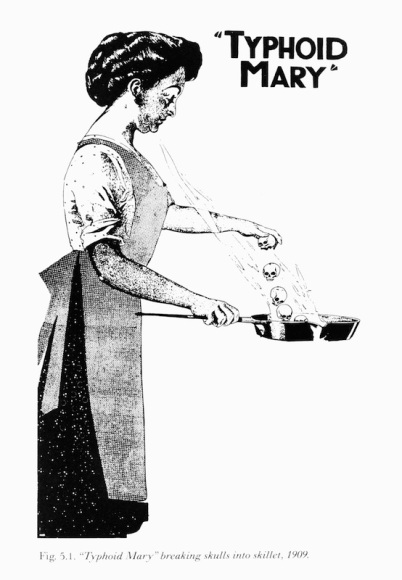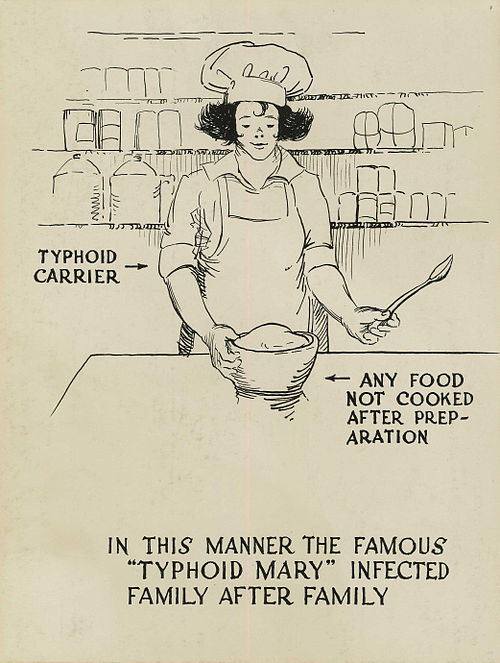Typhoid Mary–Villain or Victim?
Typhoid fever was responsible for the deaths of many people in the 19th and early part of the 20th century. Associated with poor sanitation, it was mostly confined to the lower classes, who lived in filth and squalor in the larger cities in America. At that time, one out of every ten people who became infected with the disease died from their symptoms. But when an outbreak occurred in the exclusive Oyster Bay section of Long Island, the medical profession had to figure out another source of its spread. Their conclusion, after many suppositions and dead ends, was a cook in one of these fine homes was a carrier of the disease even though she had no symptoms herself. They set out on a mission to contain the woman, and the disease.

Mary Mallon in quarantine, circa 1909
But who was this woman who led the New York public health officials on such a merry chase for years? Mary Mallon an Irish immigrant, and a fine cook, was born in September, 1869, in County Tyrone in Ireland and immigrated to the United States in 1883. In New York, she became a household servant. In the span of seven years, from 1900 to 1907, nearly two dozen people in the households where she worked contracted the disease.
Mary must have known she was responsible for their illnesses, because, by the time the common thread was discovered, she’d left the employ of the household and had moved on. Even though she was an extremely healthy woman, when tests were finally performed on her, all the results proved her to be extremely contagious, and health officials only released her from quarantine after three years on her promise that she would not enter into any kind of service where she would spread the disease. But the woman was only trained to be a cook, so she continued her profession, under various assumed names, and running from one household to another if there was any sign of illness. She did not understand how she could be spreading the disease since she wasn’t sick herself, and she had to work in order to survive.

Newspaper rendering of Mary cracking skulls into a skillet.
The Oyster Bay outbreak brought Mary to the attention of George Soper, who specialized in studying the spread of the disease. Soper met Mary in 1907, when she resurfaced in a Park Avenue home where one family member had perished from typhoid. Upon interviewing her and asking for samples of urine, feces and blood from her, he was able to link her to all 22 deaths from typhoid that had occurred in New York City and Long Island. She fled from Soper, brandishing a meat fork, but was tracked down and sent to North Brother Island for three years, despite an appeal to the Supreme Court.
What could officials do? They were violating Mary’s civil rights, but yet she was a danger to the public’s health. She broke her promise not to be employed as a cook again and her reign of contamination continued. They finally tracked her again to the kitchen of a hospital, where 25 workers, including doctors and nurses, had been infected. Poor Mary was shipped back to isolation for the remainder of her life. If only one of these health officials had instilled upon her the necessity of washing her hands, this could all have been avoided.

Poster showing the proper care of food preparation, after the results of Mary’s tests
There are other instances of healthy carriers of the disease, but those people, both men, were allowed to continue living their lives with only a brief interruption by health officials. It was believed Mary was singled out because she was Irish, a single woman, a domestic servant, and had a temper.
Until her death, she was convinced the law was wantonly persecuting her. Her last 23 years were spent alone. In the end she died, not due to typhoid, but from complications from a stroke. She had been taken by force, against her will and held without a trial, even though she had broken no laws.
In all, fifty-one cases and three deaths were attributed to coming into contact with Typhoid Mary.
http://time.com/3563182/typhoid-mary/
https://www.britannica.com/biography/Typhoid-Mary
https://www.thoughtco.com/typhoid-mary-1779179
https://en.wikipedia.org/wiki/Mary_Mallon
___________________________________________________________________________________________
Becky Lower writes mostly American historical romances, but occasionally crosses the pond to Regency England. In addition to History Imagined, she has a weekly blog at http://beckylowerauthor.blogspot.com.
While doing research for a new American historical series, she uncovered a woman we’ve all probably heard of but never knew much about–Typhoid Mary, and thought her worthy of her own post on History Imagined.
Click here to find out more about Becky’s books: http://www.beckylowerauthor.com
Great article, good information.
LikeLike
Great article, Becky! Interesting that the doctors did not or could not impress upon her the importance of hand washing!
LikeLike
Fascinating to learn the typhoid details. Unimaginable, wasn’t it? Thanks for this history. Gail 203-372-3777
Gail Ingis, ASID Curator of Art Lockwood-Mathews Mansion Museum
INDIGO SKY | “A Triumphant Tale of Courage.” Get this one!” 5-Star Gail Ingis, Author and Visual Artist http://www.gaiingis.com | gailingisclaus@gmail.com
Website | Artist Page | Amazon | Facebook | Goodreads | Twitter | Trailer | B&N
>
LikeLike
Thanks, Gail, for visiting History Imagined today. If this had happened in our current society, imagine the outcry. In some ways, we have come a long way.
LikeLike
Hand washing! What a concept!
LikeLike
this is a great article Becky.
We had to study old Mary in Nursing School–It just seemed so unbelievable that it took so long to add up her contacts!
LikeLiked by 1 person
What an interesting article. Poor Mary 😦 Thanks for sharing.
LikeLike